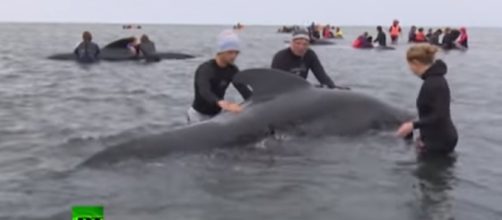Is there a connection between climate change and the worldwide rise in whale and dolphin strandings over the past two years? All along the North Atlantic coast, from the Gulf of St. Lawrence in Canada through Maine, Cape Cod and Rhode Island to North Carolina, unusually large numbers of cetaceans have been stranding. While many have been rescued and moved back to deeper waters, in the U.S. alone, the National Oceanic and Atmospheric Administration (NOAA) Fisheries has recorded 46 whale deaths in 2016 and 2017. In February this year, hundreds of whales were stranded in New Zealand, in remote areas difficult for rescuers to reach.
Many died before they could be moved back into the water.
An unusual marine mortality event
The North Atlantic strandings include different species like the endangered North Atlantic right whales, pilot whales, humpbacks, dolphins and harbor porpoises. Dolphin strandings in 2017 are unusual for their large numbers and demographics. Unlike the strandings of younger males seen earlier, those found this year included otherwise healthy young females with calves, showing signs of stress and shock. For about a fourth of the whales, the cause of death has been determined to be blunt force trauma such as would be caused by a collision with a boat propeller or entanglement. The strandings and deaths meet the definition of an unusual marine mortality event.
This is defined in the Marine Mammal Protection Act: “a stranding that is unexpected; involves a significant die-off of any marine mammal population, and demands an immediate response.”
Impact of climate change
There are many different reasons for the stranding of marine mammals. Cape Cod, with its hook-like shape jutting out into the ocean and confusing tidal channels and currents, has long been known as a stranding hotspot. Whales and dolphins may swim in too close to the shore to escape predators or noise produced by sonar or undersea oil exploration.
The See The Wild Organisation points out on their Website that "Whales are susceptible to entanglement in commercial fishing gear. This can slow whales down, weakening them, and can prohibit them from feeding leading to eventual starvation and death."
According to the UK-based charity Whale and Dolphin Conservation, climate change and its impact on the oceans plays a role.
High winds and extreme tides can confuse the Whales And Dolphins, pushing them closer to the shore and putting them at risk of stranding when the tide falls. Scientists have recorded the rise in oceanic water temperatures and the acidification of seawater. This contributes to the decline in food sources. All of these changes, along with the loss of polar habitat, impact marine mammals and other oceanic lifeforms.
The most recent whale strandings in the U.S. happened on Monomoy Island in Cape Cod at the end of June. These were two juvenile humpback whales, with no signs of injury. Both were in a weakened condition, which may have contributed to the stranding. Nevertheless, many whale strandings in remote places are thought to go unreported.
The unusual number of mass strandings is a clear indication of the state of the marine environment. In accordance with the Marine Mammals Protection Act, it calls for urgent action to address the immediate and long-term problems.


